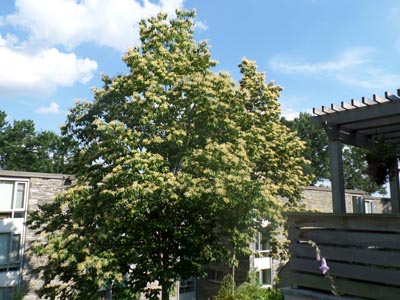Plants of the Week: July 26
 Hibiscus ‘Lord Baltimore’ is a hardy hibiscus with large crimson red blooms. These dinner plate-sized flowers display five slightly overlapping ruffled petals that will grab anyone’s attention from across the garden. In the middle of each flower is a showy and prominent central staminal column that all hibiscuses are notorious for. While individual flowers only last for a single day, one or more flowers usually bloom each day in succession throughout mid-summer to early autumn. This vigorous plant reaches 4-5’ in height with lobed green leaves and sturdy, woody, reddish-brown stems. Hibiscus ‘Lord Baltimore’ does best in full sun and should be cut down to 3-4” in late autumn.
Hibiscus ‘Lord Baltimore’ is a hardy hibiscus with large crimson red blooms. These dinner plate-sized flowers display five slightly overlapping ruffled petals that will grab anyone’s attention from across the garden. In the middle of each flower is a showy and prominent central staminal column that all hibiscuses are notorious for. While individual flowers only last for a single day, one or more flowers usually bloom each day in succession throughout mid-summer to early autumn. This vigorous plant reaches 4-5’ in height with lobed green leaves and sturdy, woody, reddish-brown stems. Hibiscus ‘Lord Baltimore’ does best in full sun and should be cut down to 3-4” in late autumn.
Photo Credit: Aaron D’Addio
Garden Location: Terry Shane Teaching Garden
While Aechmea ‘Del Mar’ is a tropical plant, after seeing this plant’s breath-taking bloom, you will gladly find some room for it indoors during the winter months. Aechmea translates to “spear tip” due to its spiny-edged foliage. At first, this plant resembles all other bromeliads with its long, thick, sharp, green leaves. However, when it blooms, the blooms of Aechmea ‘Del Mar’ are much more beautiful than any other bromeliad! Its flowers are a work of art that last all summer long. A one-foot fuchsia flower spike rises from the center of the foliage containing flower clusters of varying shades of blue and purple that will instantly spark up any light shade garden. Like all other bromeliads, it likes to collect water in its central cup at all times and the mother plant dies after flowering, but is replaced by its “pups” that form at its base.
Photo Credit: Aaron D’Addio
Garden Location: Terry Shane Teaching Garden
 Poliothyrsis sinensis, or Chinese pearlbloom, is a medium-sized flowering tree that I do not come across very frequently. It is often mistaken for tree-lilac, however this plant blooms much later. Chinese pearlbloom showcases fragrant, airy, terminal, pinnacle inflorescences that start off pearl and transform to pale yellow on reddish stems. Poliothyrsis sinensis likes full sun and displays burgundy fall foliage.
Poliothyrsis sinensis, or Chinese pearlbloom, is a medium-sized flowering tree that I do not come across very frequently. It is often mistaken for tree-lilac, however this plant blooms much later. Chinese pearlbloom showcases fragrant, airy, terminal, pinnacle inflorescences that start off pearl and transform to pale yellow on reddish stems. Poliothyrsis sinensis likes full sun and displays burgundy fall foliage.
Photo Credit: Aaron D’Addio
Garden Location: Wister Center, Entrance Garden
 This plant is on fire! Woodwardia unigemmata, commonly known as chain fern, features large fern frond foliage. This plant displays new foliage with flame-shaped leaflets which start off copper then slowly fades to green from the inside outwards resembling a leaf that is covered in flames. Unigemmata translates to “one bud” referring to how this plant reproduces by forming a single, small, fuzzy gemma or ball, which will eventually become a new chain fern plant. Woodwardia unigemmata is evergreen but borderline-hardy to this area and does best in light shade and moist soil.
This plant is on fire! Woodwardia unigemmata, commonly known as chain fern, features large fern frond foliage. This plant displays new foliage with flame-shaped leaflets which start off copper then slowly fades to green from the inside outwards resembling a leaf that is covered in flames. Unigemmata translates to “one bud” referring to how this plant reproduces by forming a single, small, fuzzy gemma or ball, which will eventually become a new chain fern plant. Woodwardia unigemmata is evergreen but borderline-hardy to this area and does best in light shade and moist soil.
Photo Credit: Aaron D’Addio
Garden Location: Terry Shane Teaching Garden






No Comments